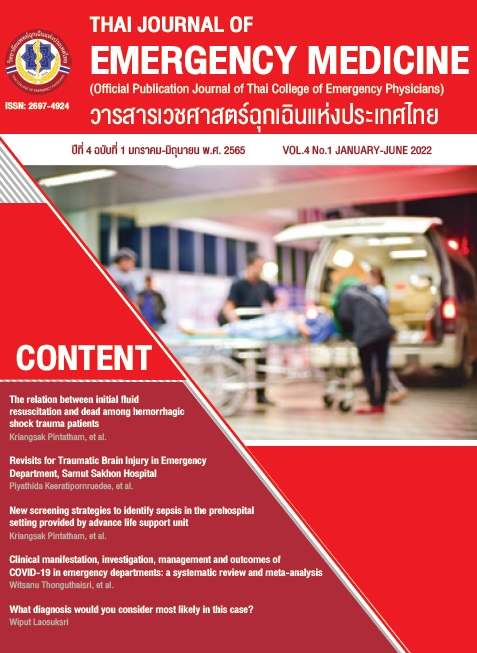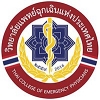The relation between initial fluid resuscitation and dead among hemorrhagic shock trauma patients
Keywords:
Trauma, Hemorrhagic shock, trauma deadAbstract
Introduction Traffic accident is the leading cause of traumatic death in Thailand. It is necessary to provide fluids and blood in traumatic hemorrhagic shock patient. The proper amount of volume resuscitation in the early stage of treatment is crucial to predict the outcome of the patient. It is therefore important to predict the outcome of the patient's treatment process.
Objective To study the amount of fluid in the early stages and the mortality rate in trauma patients with shock. from blood loss
Methodology This was a retrospective cohort study where patients were divided into two groups. The frst group was traumatic patients who had shock in the early stages. Volume not more than 2,000 ml and the second group of accident patients with shock received in the early stages volume more than 2,000 ml. 24-hour mortality, 30-day mortality, acidosis abnormal blood clotting, surgery and hospitalization were observed.
Results There were 236 patients in this study, divided into two groups, 120 patients in small volume resuscitation group (initial IV fluide resuscitation less than 2000 ml.) and 116 patients in large volume resuscitation group (initial IV fluide resuscitation more than 2000 ml.). The clinical outcomes were death within 24 hours OR 0.86 (95%CI 0.49 - 1.50, p value 0.590). clotting abnormally adjusted OR 1.61 (95% CI 0.79 - 3.28, p value 0.188) acidosis adjusted OR 1.70 (95% CI 0.76 - 3.83, p value 0.196) operative adjusted OR 1.91 (95% CI 0.90 - 4.07, p value 0.092)
Conclusion The volume of fluid administered at the initial stage in a traumatic shock patient, it was not associated with mortality and, the incidence of acidosis, coagulopathy, and patients' surgical visits.
References
Sharon Henry, Karen Brasel, Ronald M. Stewart. Advanced Trauma Life Support (ATLS). American College of Surgeons. 10th edition. 2018.
G. H. Ramesh, J. C. Uma and Sheerin Farhath. Fluid resuscitation in trauma: what are the best strategies and fluids? International Journal of Emergency Medicine (2019) 12:38
Yasuaki Mizushima, Shota Nakao, Koji Idoguchi, Tetsuya Matsuoka. Fluid resuscitation of trauma patients: How much fluid is enough to determine the patient's response? American Journal of Emergency Medicine 35 (2017) 842–845
Chih-Hung Wang, Wen-Han Hsieh, Hao-Chang Chou, Yu-Sheng Huang, Jen-Hsiang Shen, Yee Hui Yeo, Huai-En Chang, Shyr-Chyr Chen, Chien-Chang Lee, Liberal Versus Restricted Fluid Resuscitation Strategies in Trauma Patients: A Systematic Review and Meta-Analysis of Randomized Controlled Trials and Observational Studies. Critical care medicine. Volume 42 number 4. April 2014.
Ley EJ, Clond MA, Srour MK, Barnajian M, Mirocha J, Margulies DR, et al. Emergency department crystalloid resuscitation of 1.5 L or more is associated with increased mortality in elderly and nonelderly trauma patients [Internet]. The Journal of trauma. U.S. National Library of Medicine; 2011 [cited 2020May3]. Available from: https://www.ncbi.nlm.nih.gov/pubmed/21307740
Adeva-Andany MM, Fernández-Fernández C, Mouriño-Bayolo D, Castro-Quintela E, Domínguez-Montero A. Sodium bicarbonate therapy in patients with metabolic acidosis. The Scientific World Journal. 2014; 2014:1–13.
Centor RM. Serum Total Carbon Dioxide. In: Walker HK, Hall WD, Hurst JW, editors. Clinical Methods: The History, Physical, and Laboratory Examinations. 3rd edition. Boston: Butterworths; 1990. Chapter 196. Available from: https://www.ncbi.nlm.nih.gov/books/NBK308/
Sherilyn Alvaran Tuazon MD. Prothrombin time: Reference range, interpretation, collection and panels [Internet]. Prothrombin Time: Reference Range, Interpretation, Collection and Panels. Medscape; 2021 [cited 2022Mar30]. Available from: https://emedicine.medscape.com/article/2086058-overview
Gauer RL, Braun MM. Thrombocytopenia [Internet]. American Family Physician. 2012 [cited 2022Mar30]. Available from: https://www.aafp.org/afp/2012/0315/p612.html
Marqués CG, Moretti K, Amanullah S, Uwamahoro C, Ndebwanimana V, Garbern S, et al. Association between volume resuscitation & mortality among injured patients at a tertiary care hospital in Kigali, Rwanda. African Journal of Emergency Medicine. 2021;11(1):152–7.
Hussmann B, Schoeneberg C, Jungbluth P, Heuer M, Lefering R, Maek T, et al. Enhanced prehospital volume therapy does not lead to improved outcomes in severely injured patients with severe traumatic brain injury. BMC Emergency Medicine. 2019;19(1).
Heuer M, Hussmann B, Lefering R, Kaiser GM, Eicker C, Guckelberger O, et al. Prehospital fluid management of abdominal organ trauma patients—a matched pair analysis. Langenbeck's Archives of Surgery. 2015;400(3):371–9.
Zhao G, Wu W, Feng Q-ming, Sun J. Evaluation of the clinical effect of small-volume resuscitation on uncontrolled hemorrhagic shock in emergency. Therapeutics and Clinical Risk Management. 2017; Volume 13:387–92.
Elkbuli A, Zajd S, Ehrhardt JD, McKenney M, Boneva D. Aggressive crystalloid resuscitation outcomes in low-severity pediatric trauma. Journal of Surgical Research. 2020; 247:350–5.
Hussmann B, Lefering R, Kauther M, Ruchholtz S, Moldzio P, Lendemans S. Influence of prehospital volume replacement on outcome in polytraumatized children. Critical Care. 2012;16(5).
Ley EJ, Clond MA, Srour MK, Barnajian M, Mirocha J, Margulies DR, et al. Emergency department crystalloid resuscitation of 1.5 L or more is associated with increased mortality in elderly and nonelderly trauma patients. Journal of Trauma: Injury, Infection & Critical Care. 2011;70(2):398–400.
Ramesh GH, Uma JC, Farhath S. Fluid resuscitation in trauma: What are the best strategies and fluids? International Journal of Emergency Medicine. 2019;12(1).

Downloads
Published
How to Cite
Issue
Section
Categories
License
Copyright (c) 2022 Thai Collage of Emergency Physicians

This work is licensed under a Creative Commons Attribution-NonCommercial-NoDerivatives 4.0 International License.
บทความที่ได้รับตีพิมพ์ในวารสารเวชศาสตร์ฉุกเฉินแห่งประเทศไทย ถือเป็นเป็นลิขสิทธิ์ของ วิทยาลัยแพทย์เวชศาสตร์ฉุกเฉินแห่งประเทศไทย
กรณีที่บทความได้รับการตีพิมพ์ในวารสารเวชศาสตร์ฉุกเฉินแห่งประเทศไทยแล้ว จะตีพิมพ์ในรูปแบบอิเล็กทรอนิกส์ ไม่มีสำเนาการพิมพ์ภายหลังหนังสือเผยแพร่เรียบร้อยแล้ว ผู้นิพนธ์ไม่สามารถนำบทความดังกล่าวไปนำเสนอหรือตีพิมพ์ในรูปแบบใดๆ ที่อื่นได้ หากมิได้รับคำอนุญาตจากวารสารเวชศาสตร์ฉุกเฉินแห่งประเทศไทย



